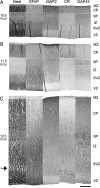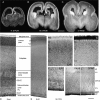A molecular neuroanatomical study of the developing human neocortex from 8 to 17 postconceptional weeks revealing the early differentiation of the subplate and subventricular zone
- PMID: 17965125
- PMCID: PMC2430151
- DOI: 10.1093/cercor/bhm184
A molecular neuroanatomical study of the developing human neocortex from 8 to 17 postconceptional weeks revealing the early differentiation of the subplate and subventricular zone
Abstract
We have employed immunohistochemistry for multiple markers to investigate the structure and possible function of the different compartments of human cerebral wall from the formation of cortical plate at 8 postconceptional weeks (PCW) to the arrival of thalamocortical afferents at 17 PCW. New observations include the subplate emerging as a discrete differentiated layer by 10 PCW, characterized by synaptophysin and vesicular gamma-aminobutyric acid transporter expression also seen in the marginal zone, suggesting that these compartments may maintain a spontaneously active synaptic network even before the arrival of thalamocortical afferents. The subplate expanded from 13 to 17 PCW, becoming the largest compartment and differentiated further, with NPY neurons located in the outer subplate and KCC2 neurons in the inner subplate. Glutamate decarboxylase and calretinin-positive inhibitory neurons migrated tangentially and radially from 11.5 PCW, appearing in larger numbers toward the rostral pole. The proliferative zones, marked by Ki67 expression, developed a complicated structure by 12.5 PCW reflected in transcription factor expression patterns, including TBR2 confined to the inner subventricular and outer ventricular zones and TBR1 weakly expressed in the subventricular zone (SVZ). PAX6 was extensively expressed in the proliferative zones such that the human outer SVZ contained a large reservoir of PAX6-positive potential progenitor cells.
Keywords: cell migration; cortical development; immunohistochemistry; synaptogenesis.
Figures








References
-
- Aguado F, Carmona MA, Pozas E, Aguilo A, Martinez-Guijarro FJ, Alcantara S, Borrell V, Yuste R, Ibanez CF, Soriano E. BDNF regulates spontaneous correlated activity in early developmental stages by increasing synaptogenesis and expression of the K+/Cl- co-transporter KCC2. Development. 2003;130:1267–1280. - PubMed
-
- Altman J, Bayer SA. Regional differences in the stratified transitional field and honeycomb matrix of the developing human cerebral cortex. J Neurocytol. 2002;31:613–622. - PubMed
-
- Ben-Ari Y, Khalilov I, Represa A, Gozlan H. Interneurons set the tune of developing networks. Trends Neurosci. 2004;27:422–427. - PubMed
-
- Benowitz LI, Routtenberg A. GAP43; an intrinsic determinant of neuronal development and plasticity. Trends Neurosci. 1997;20:84–91. - PubMed
Publication types
MeSH terms
Substances
Grants and funding
LinkOut - more resources
Full Text Sources
Other Literature Sources
Medical
Miscellaneous

